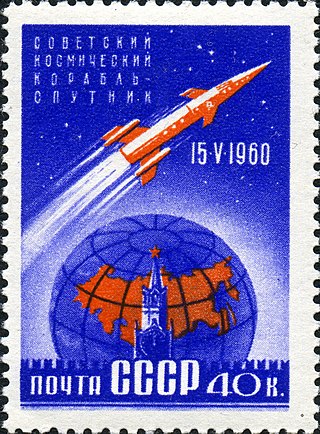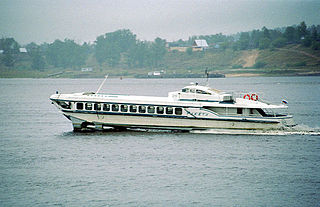A hydrofoil is a lifting surface, or foil, that operates in water. They are similar in appearance and purpose to aerofoils used by aeroplanes. Boats that use hydrofoil technology are also simply termed hydrofoils. As a hydrofoil craft gains speed, the hydrofoils lift the boat's hull out of the water, decreasing drag and allowing greater speeds.

The Soyuz programme is a human spaceflight programme initiated by the Soviet Union in the early 1960s. The Soyuz spacecraft was originally part of a Moon landing project intended to put a Soviet cosmonaut on the Moon. It was the third Soviet human spaceflight programme after the Vostok (1961–1963) and Voskhod (1964–1965) programmes.
Vostok refers to east in Russian but may also refer to:

S.P. Korolev Rocket and Space Corporation "Energia" is a Russian manufacturer of spacecraft and space station components. Its name is derived from the Russian word for energy and is also named for Sergei Pavlovich Korolev, the first chief of its design bureau and the driving force behind early Soviet accomplishments in space exploration.

The Voskhod programme was the second Soviet human spaceflight project. Two one-day crewed missions were flown using the Voskhod spacecraft and rocket, one in 1964 and one in 1965, and two dogs flew on a 22-day mission in 1966.

Voskhod 1 was the seventh crewed Soviet space flight. Flown by cosmonauts Vladimir Komarov, Konstantin Feoktistov, and Boris Yegorov, it launched 12 October 1964, and returned on the 13th. Voskhod 1 was the first human spaceflight to carry more than one crewman into orbit, the first flight without the use of spacesuits, and the first to carry either an engineer or a physician into outer space. It also set a crewed spacecraft altitude record of 336 km (209 mi).

Voskhod 2 was a Soviet crewed space mission in March 1965. The Vostok-based Voskhod 3KD spacecraft with two crew members on board, Pavel Belyayev and Alexei Leonov, was equipped with an inflatable airlock. It established another milestone in space exploration when Alexei Leonov became the first person to leave the spacecraft in a specialised spacesuit to conduct a 12-minute spacewalk.

Alexei Arkhipovich Leonov was a Soviet and Russian cosmonaut, Air Force major general, writer, and artist. On 18 March 1965, he became the first person to conduct a spacewalk, exiting the capsule during the Voskhod 2 mission for 12 minutes and 9 seconds. He was also selected to be the first Soviet person to land on the Moon although the project was cancelled.

Korabl-Sputnik 1, also known as Sputnik 4 in the West, was the first test flight of the Soviet Vostok programme, and the first Vostok spacecraft. It was launched on May 15, 1960. Though Korabl-Sputnik 1 was uncrewed, it was a precursor to the first human spaceflight, Vostok 1. Its mass was 4,540 kilograms (10,010 lb), of which 1,477 kilograms (3,256 lb) was instrumentation.
Kosmos is a designation given to many satellites operated by the Soviet Union and subsequently Russia. Kosmos 1, the first spacecraft to be given a Kosmos designation, was launched on 16 March 1962.

The Voskhod was a spacecraft built by the Soviet Union's space program for human spaceflight as part of the Voskhod programme. It was a development of and a follow-on to the Vostok spacecraft. Voskhod 1 was used for a three-man flight whereas Voskhod 2 had a crew of two. They consisted of a spherical descent module, which housed the cosmonauts, and instruments, and a conical equipment module, which contained propellant and the engine system. Voskhod was superseded by the Soyuz spacecraft in 1967.
The Voskhod rocket was a derivative of the Soviet R-7 ICBM designed for the human spaceflight programme but later used for launching Zenit reconnaissance satellites. It was essentially an 8K78/8K78M minus the Blok L stage and spec-wise was a halfway between the two boosters, with the former's older, lower-spec engines and the latter's improved Blok I design. Its first flight was on 16 November 1963 when it successfully launched a Zenit satellite from LC-1/5 at Baikonur. Boosters used in the Voskhod program had a man-rated version of the RD-0107 engine; this version was known as the RD-0108.

Voskhod is the name of several types of motorcycles produced at the Degtyaryov Plant in the Russian town of Kovrov since 1965.

Raketa was the first type of hydrofoil boats commercially produced in the Soviet Union. First planned in the late 1940s as "project 340" by chief designer Rostislav Alexeyev, the vessels were manufactured from 1957 until the early 1970s.

Voskhod, also known as "Design 352", "Design 03521" and Eurofoil, is a type of passenger hydrofoil boat built in the Soviet Union and later in Ukraine. It is intended for use in rivers and lakes, but good seaworthiness allows them to operate in coastal sea areas as well.

The Polyot was an interim orbital carrier rocket, built to test ASAT spacecraft. It was required as a stopgap after the cancellation of the UR-200 programme, but before the Tsyklon could enter service. Only two were ever launched, the first on 1 November 1963, and the last on 12 April 1964. Both of these flights were successful.

Globus IMP instruments were spacecraft navigation instruments used in Soviet and Russian crewed spacecraft. The IMP acronym stems from the Russian expression Indicator of position in flight, but the instrument is informally referred to as the Globus. It displays the nadir of the spacecraft on a rotating terrestrial globe. It functions as an onboard, autonomous indicator of the spacecraft's location relative to Earth coordinates. An electro-mechanical device in the tradition of complex post-World War II clocks such as master clocks, the Globus IMP instrument incorporates hundreds of mechanical components common to horology. This instrument is a mechanical computer for navigation akin to the Norden bombsight. It mechanically computes complex functions and displays its output through mechanical displacements of the globe and other indicator components. It also modulates electric signals from other instruments.
Kosmos 120 or Zenit-2 No.41 was a Soviet, first generation, low resolution, optical film-return reconnaissance satellite launched in 1966. A Zenit-2 spacecraft, Kosmos 120 was the thirty-ninth of eighty-one such satellites to be launched and had a mass of 4,730 kilograms (10,430 lb).
Kosmos 57 was an uncrewed Soviet spacecraft launched on 22 February 1965. The craft was essentially an uncrewed version of Voskhod 2. Its primary mission was to test the Volga airlock. The test was successful, but the craft was lost shortly after. The spaceflight is designated under the Kosmos system, placing it with many other Soviet scientific and military satellites.











